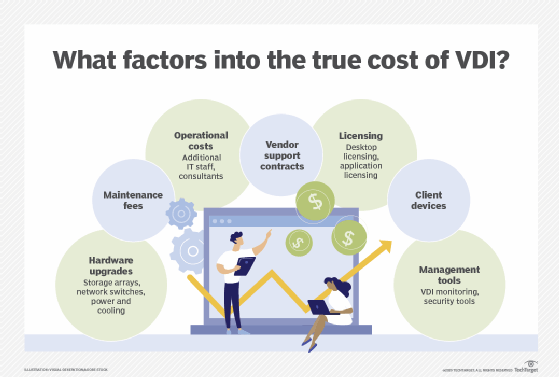
agcreativelab - stock.adobe.com
Why COVID-19 fuels desktop virtualization trends
VDI products provide organizations with a foundation for remote employees, but they aren't a cure-all.
As more organizations begin to shift toward a work-from-home model, desktop virtualization is trending because it provides manageability, flexibility and accessibility.
Following nationwide shutdowns to curb the pandemic, many organizations had to quickly adopt and implement a compute foundation to support remote workers. VDI emerged as a logical fit and organizations deployed VDI products in large numbers. Experts predict COVID-19 demands will influence 70% of desktop virtualization business cases through 2023, according to Gartner Inc.
A growing market
In many cases, the shift to remote work isn't temporary. Studies show that eight out of 10 organizations implemented universal work-from-home policies as a result of COVID-19, and two out of three -- 67% -- plan to keep these policies in place, according to 451 Research.
The end result is a growing use of VDI. The value of the worldwide VDI market was at $4,490 million in 2019 and experts project that number to reach $12,971.3 million by 2027 -- a CAGR of 14.4% from 2019 to 2027 -- according to ResearchandMarkets.
A good fit for remote work
VDI is a good fit for remote work because it centralizes desktop images and eliminates traditional desktop management challenges, such as system updates. Software constantly improves and hackers incessantly test and attack corporate systems. Rather than updating software on every desktop individually, VDI enables IT teams to update one system image and make it available to every user as they log in.
In addition, VDI is cost-effective. When IT teams patch and update each device or persistent image, the device becomes inaccessible for 5 minutes to 45 minutes. But with VDI, updates are available immediately upon login, which helps reduce operational costs.

Additionally, VDI helps avoid unnecessary downtime. In some cases, installing backup software for traditional desktop systems can take anywhere from 10 to 40 minutes for each end device. But when IT teams discover an issue within a VDI system, users are immediately switched to a good image, according to Gartner.
VDI can also respond to fluctuating demands. Most organizations had little to no warning when the pandemic struck and many weren't prepared for nonessential business closures. As the health crisis continues to drag on, regulations are in flux. But IT teams can scale VDI up and down as needed.
"Flexibility is another attraction with VDI," said Andrew Hewitt, analyst at Forrester Research.
PCs come in all shapes and sizes. Users want more control over the devices they run, and IT teams want to satisfy user expectations. But IT teams must also balance user freedom with security and compliance requirements. With VDI, users can access critical information from any device of their choosing.
IT teams are often content because they have unified endpoint management (UEM) tools that ensure user devices operate within appropriate boundaries, according to Gartner. Organizations must ensure that users adopt a consistent security profile whenever they use corporate resources.
Challenges on the horizon
VDI isn't a cure-all. Experts predict more than 80% of desktop virtualization projects deployed to reduce costs rather than to improve security or business continuity will fail to meet their objectives, according to Gartner. Organizations save money by reducing compute resources. But organizations must invest in data center server, storage and network devices to ensure operational efficiency.
Bandwidth contention is another VDI challenge. Network capacity assumes that not every user will be online simultaneously. With more organizations operating remotely, that assumption is being tested. As a result, the performance of multi-media and bandwidth-intensive applications -- such as video conferencing and complex engineering applications -- suffers.
In addition, VDI introduces a single point of failure.
"Since everyone is using the same central system, delays and outages become more widespread," Hewitt said.
When an outage occurs within a VDI system, online users get knocked offline. But in a traditional desktop environment, individual users' devices encounter issues, not the entire system.






